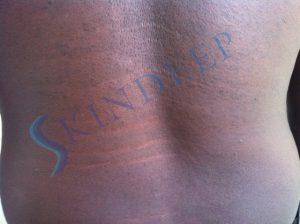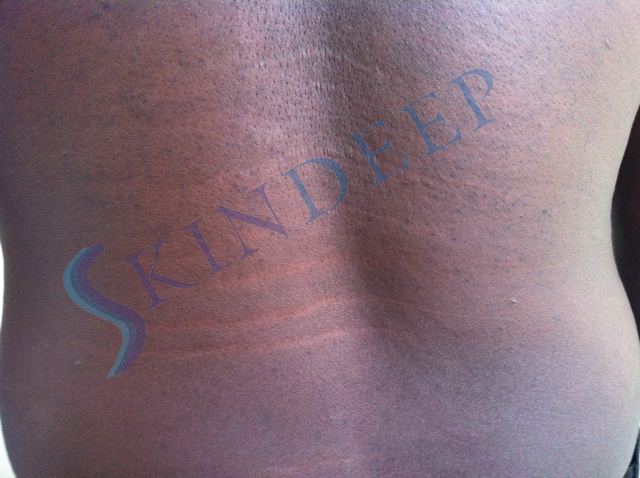Stretch marks are irregular, elongated areas which look like bands or stripes on the skin. They represent linear scars or tearing involving the layer under the surface (dermis) as well as surface (epidermis) of the skin. There is damage to collagen and elastin, which are necessary components of healthy skin.

Striae are especially common among adolescent girls and boys but adults can also develop them due to a variety of factors. Certain situations predispose to striae.
Common causes are:
- Pregnancy. Pregnant females undergo continuous and progressive stretching of the skin. The breasts, abdomen and thighs are especially vulnerable.
- Rapid weight gain. Weight gain and growth occurs in adolescents, bodybuilders and individuals who eat too much.
- Medications. Corticosteroid creams, ointments and lotions can make the skin thinner if overused and abused, especially in those who like to “bleach” the skin or have chronic steroid responsive skin problems. Systemic corticosteroids and anabolic steroids are also culprits.
- Specific diseases. Cushing’s disease is associated with increased circulating cortisol and striae. Marfan Syndrome and Ehlers-Danlos Syndrome are uncommon causes.
Initial signs of stretch marks may be raised skin coloured lines in dark skin or flattened red/purplish thin lines. The lines can be several centimetres long and up to one centimetre wide. Older lesions become whitish and thinner. The surface of the skin can developed a wrinkled appearance if there are numerous small mature striae. The orientation of these marks is usually perpendicular to the direction of skin stretching. Over time the lesions become less noticeable and significant.
Tretinoin cream 0.1% is useful for early pink lesions but is not used during pregnancy or nursing. This cream exfoliates and helps to rebuild collagen but also causes irritation. It is a relatively affordable treatment for early lesions.
Chemical peels with trichloroacetic acid have been tried as well as physical superficial methods like microdermabrasion. Microdermabrasion is useful for minor improvements of older marks but is too superficial a modality to be effective. Deeper dermabrasion can results in discoloration or scars and should be performed with caution. It is certainly not applicable for black skin.
Laser treatments stimulate the production of collagen and elastin and are often used. Various modalities are selected based on the age, location and severity of the problem.
Micro-needling is a minimally invasive method of collagen induction therapy. It is a promising way of inexpensively treating striae. As each needle punctures the skin it produces a micro-wound that stimulates more collagen and elastin in the dermis. This is one of the safest skin treatment procedures available.
Medical treatment is only necessary in cases where there is a cosmetic concern. It is important to have realistic expectations regarding the results from the available options. There is no perfect treatment that will result in complete resolution of striae.

